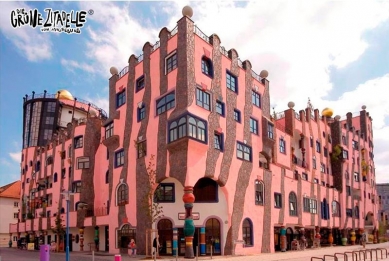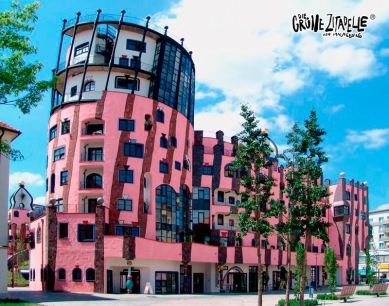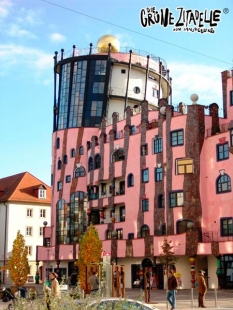
The biggest attraction of Magdeburg is the Hundertwasser Citadel
Magdeburg - The German Magdeburg boasts landmarks with a history that dates back deep into the Middle Ages. One of its biggest tourist attractions has become the originally criticized eccentric Green Citadel - the last building designed by the eccentric Austrian architect Friedensreich Hundertwasser, who gained international fame for a similarly unconventional building in Vienna bearing his name. Unlike the one in Vienna, however, it is possible to glimpse into the interior spaces of the complex in Magdeburg and at least for a moment experience what it is like to live in a building intertwined with trees, with wavy floors and with a different handle on every door.
The first thing that is likely to strike every visitor is not so much the architectural concept of the modern building, but the color of its facade. The Green Citadel is predominantly pink. "Hundertwasser chose the pink color as a contrast to the surrounding buildings," explains guide Karin Frank.
The nickname "green" was given because its roofs are covered with grass and trees. "Hundertwasser said that he made a pact with nature. What he took from it on the ground, he gave back to the roof," states Frank. The term citadel refers to the historic Magdeburg fortress on the Elbe River, which flows through the city.
On the site of Hundertwasser's house originally stood a church, which, like most of the buildings in the Saxony-Anhalt metropolis, fell victim to bombing at the end of World War II. The East German regime built an ugly six-story panel building in its place, which the city decided to replace with something more original after the fall of communism.
In the sight of the majestic Gothic cathedral, where the famous Emperor Otto I the Great is buried, Hundertwasser's project was built from 2003 to 2005 in the spirit of his philosophy of rejecting straight lines and regularity and striving to combine greenery with architecture. "It is an oasis for humanity and nature in a sea of rational houses," the author himself said, designating the building as his most beautiful and best work - at least according to the claims of the Magdeburg residents.
Interestingly, Hundertwasser never saw the work with his own eyes, as he died in 2000 during a voyage from New Zealand to Europe. His friend, Austrian architect Peter Pelikan, who was also involved in planning the famous Hundertwasser house in Vienna, took over the completion of the project.
From the outside, the Green Citadel does indeed resemble a fortress. The rooftop walkway looks like battlements winding between towers topped with bulbous onion-shaped points or golden spheres. The exterior of the building and two internal courtyards are adorned with more than 140 columns and nearly 900 windows. None of these elements is identical in size, shape, or color to another. The same applies to the interiors. All entrance doors and even the handles in the apartments are unique. There are 55 apartments here, and each has a different floor plan.
Although living in Magdeburg's Hundertwasser house is not the cheapest by German standards - rent for a 90 square meter apartment costs nearly a thousand euros (over 25,000 CZK) - everything is occupied. "People don't move out from here; they live here until they die," noted Frank. According to her, the apartments can only be rented, not purchased.
Other peculiarities of the Green Citadel include wavy floors, which, according to the architect, allow a person to sense even the act of walking, and trees growing inside the house. The residents take care of them. "The tree pays them back by giving oxygen, said Hundertwasser," added the guide, quoting the Viennese native whose civil name was Friedrich Stowasser.
Besides the residential part, the complex also houses a hotel, a kindergarten, shops, galleries, restaurants, a café, a theater, and an information center. According to its manager, Patrick Knobbe-Berlt, around 25,000 interested individuals participate in building tours each year, and events held at the Green Citadel attract a total of 220,000 visitors. In terms of visitor numbers, it surpasses even the city's main tourist attraction, the Magdeburg Cathedral, which welcomed over 144,000 people last year. According to available information, only the local zoo attracted more visitors than the Green Citadel.
Originally, however, the people of Magdeburg were not too keen on the idea of constructing the eccentric Hundertwasser project in the historical heart of the city, and they derogatorily nicknamed the building "the colorful shed" due to its cost of 27 million euros (almost 700 million CZK today). Gradually, though, they grew to accept it, and it now stands as a symbol of the two-hundred-thousand-strong East German city. "And notice that, unlike others, there is absolutely no graffiti on it. Even the graffiti artists respect that building," adds Karin Frank as a final remark.
The first thing that is likely to strike every visitor is not so much the architectural concept of the modern building, but the color of its facade. The Green Citadel is predominantly pink. "Hundertwasser chose the pink color as a contrast to the surrounding buildings," explains guide Karin Frank.
The nickname "green" was given because its roofs are covered with grass and trees. "Hundertwasser said that he made a pact with nature. What he took from it on the ground, he gave back to the roof," states Frank. The term citadel refers to the historic Magdeburg fortress on the Elbe River, which flows through the city.
On the site of Hundertwasser's house originally stood a church, which, like most of the buildings in the Saxony-Anhalt metropolis, fell victim to bombing at the end of World War II. The East German regime built an ugly six-story panel building in its place, which the city decided to replace with something more original after the fall of communism.
In the sight of the majestic Gothic cathedral, where the famous Emperor Otto I the Great is buried, Hundertwasser's project was built from 2003 to 2005 in the spirit of his philosophy of rejecting straight lines and regularity and striving to combine greenery with architecture. "It is an oasis for humanity and nature in a sea of rational houses," the author himself said, designating the building as his most beautiful and best work - at least according to the claims of the Magdeburg residents.
Interestingly, Hundertwasser never saw the work with his own eyes, as he died in 2000 during a voyage from New Zealand to Europe. His friend, Austrian architect Peter Pelikan, who was also involved in planning the famous Hundertwasser house in Vienna, took over the completion of the project.
From the outside, the Green Citadel does indeed resemble a fortress. The rooftop walkway looks like battlements winding between towers topped with bulbous onion-shaped points or golden spheres. The exterior of the building and two internal courtyards are adorned with more than 140 columns and nearly 900 windows. None of these elements is identical in size, shape, or color to another. The same applies to the interiors. All entrance doors and even the handles in the apartments are unique. There are 55 apartments here, and each has a different floor plan.
Although living in Magdeburg's Hundertwasser house is not the cheapest by German standards - rent for a 90 square meter apartment costs nearly a thousand euros (over 25,000 CZK) - everything is occupied. "People don't move out from here; they live here until they die," noted Frank. According to her, the apartments can only be rented, not purchased.
Other peculiarities of the Green Citadel include wavy floors, which, according to the architect, allow a person to sense even the act of walking, and trees growing inside the house. The residents take care of them. "The tree pays them back by giving oxygen, said Hundertwasser," added the guide, quoting the Viennese native whose civil name was Friedrich Stowasser.
Besides the residential part, the complex also houses a hotel, a kindergarten, shops, galleries, restaurants, a café, a theater, and an information center. According to its manager, Patrick Knobbe-Berlt, around 25,000 interested individuals participate in building tours each year, and events held at the Green Citadel attract a total of 220,000 visitors. In terms of visitor numbers, it surpasses even the city's main tourist attraction, the Magdeburg Cathedral, which welcomed over 144,000 people last year. According to available information, only the local zoo attracted more visitors than the Green Citadel.
Originally, however, the people of Magdeburg were not too keen on the idea of constructing the eccentric Hundertwasser project in the historical heart of the city, and they derogatorily nicknamed the building "the colorful shed" due to its cost of 27 million euros (almost 700 million CZK today). Gradually, though, they grew to accept it, and it now stands as a symbol of the two-hundred-thousand-strong East German city. "And notice that, unlike others, there is absolutely no graffiti on it. Even the graffiti artists respect that building," adds Karin Frank as a final remark.
The English translation is powered by AI tool. Switch to Czech to view the original text source.




0 comments
add comment












